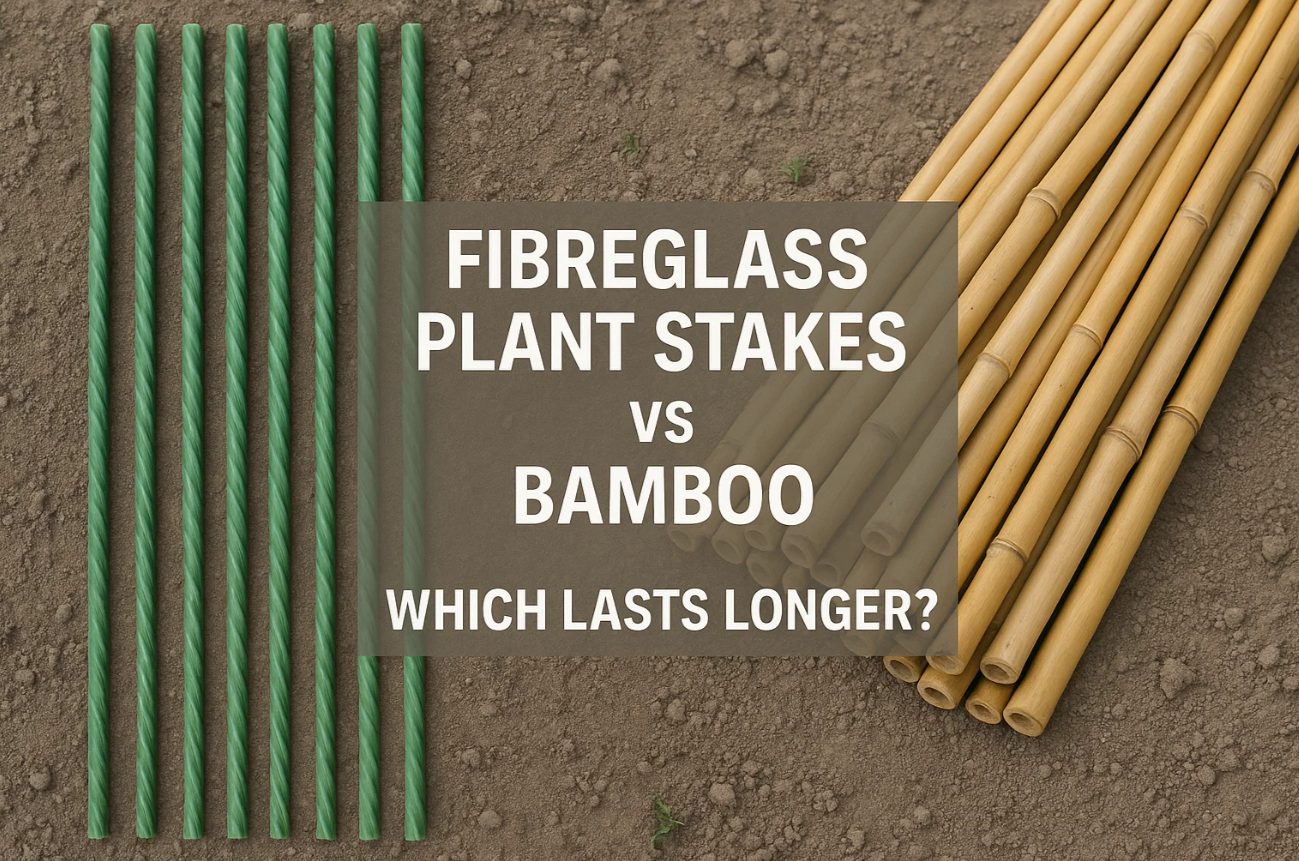Introduction
Crop support might not be the first line item you watch on a spreadsheet, yet a single mid‑season stake failure can topple thousands of dollars’ worth of fruiting plants. Many large growers therefore ask one deceptively simple question: which stakes last longer—fibreglass plant stakes or bamboo?
Unicomposite, an ISO‑certified pultrusion manufacturer that supplies engineered FRP stakes worldwide, has helped hundreds of operations run the math. Drawing on that field experience and publicly available data, this guide compares the two materials through the lens of durability, cost, and compliance so procurement teams can make a confident, people‑first decision.

fibreglass plant stakes
Why Stake Material Matters in Commercial Cultivation
Load‑bearing demands of modern greenhouse & field crops
High‑wire tomatoes, trellised cucumbers, and long‑cane berries can each exceed 6 kg (13 lb) of live load per plant. As crop genetics push yields higher, the working load on every stake rises as well. A 2023 Cornell University greenhouse study found that broken or leaning supports reduced marketable yield by 7.8 % across five trials.
The replacement cycle: labour, downtime, and waste
A 10‑hectare berry farm typically stages two labourers for one week each spring solely to pull and replace splintered bamboo stakes—roughly 160 labour‑hours that could be used for planting or IPM scouting. The same farm estimated that stake failure and re‑tie events cost another $9,600 per season in lost pick‑time productivity.
Material Science Breakdown: Fibreglass Plant Stakes
How pultruded fibreglass stakes are manufactured and quality‑tested
Pultrusion pulls glass fibre rovings through a resin bath and a heated die, curing them into a continuous, dimensionally stable rod. Unicomposite’s automated lines integrate inline ultraviolet (UV) photometry and three‑point bending tests to certify every batch—capabilities that typical commodity stake suppliers lack.
Key performance traits: corrosion resistance, dielectric safety, UV stability
Fibreglass plant stakes are chemically inert, so they do not corrode in high‑salinity fertigation or coastal air. Their dielectric properties protect workers from stray voltage in electrified greenhouse environments. Independent tests by the Asian Composite Centre recorded less than 2 % strength loss after 5,000 h of Xenon‑arc UV exposure, equivalent to roughly five field seasons.
Material Science Breakdown: Bamboo Stakes
Natural appeal, availability, and initial cost advantage
Bamboo grows rapidly and arrives ready to use with minimal processing. A pallet of 1.8 m (6 ft) canes often costs 40 % less upfront than the same length in fibreglass. That affordability keeps bamboo popular among smallholders and organic CSA farms.
Failure modes: moisture rot, pest attack, splintering under load
But nature cuts both ways. Untreated bamboo absorbs up to 20 % of its weight in water within 48 h, accelerating rot and harbouring fungal spores that can move quickly through a closed greenhouse. Agronomist Dr. L. Reyes notes, “After year two we see micro‑fractures where caterpillar larvae entered; once that happens the stake is done.” Laboratory bending tests show that bamboo loses 30 – 50 % of its flexural strength after three wet‑dry cycles.
Side‑by‑Side Longevity & Cost Analysis
Five‑season accelerated aging case study
An anonymized berry exporter in the Pacific Northwest ran parallel rows with bamboo and fibreglass plant stakes inside identical rain‑shield tunnels. After five harvest cycles:
Bamboo: 71 % replacement rate; average usable life 1.4 years.
Fibreglass: 9 % replacement rate; projected usable life 8 + years.
Total cost of ownership model: purchase, maintenance, disposal
When procurement plotted all expenses—initial purchase, installation labour, mid‑season breakage, disposal fees—fibreglass stakes delivered a 36 % lower cost per kilogram of fruit over five years even though the opening invoice was higher. The model also flagged a hidden advantage: because FRP rods are recyclable as glass‑rich filler, disposal costs dropped by $0.21 per stake versus landfill tipping fees for bamboo contaminated with crop residue.
Beyond Longevity: Sustainability & Compliance Factors
Environmental impact: lifecycle assessments and certifications
A cradle‑to‑grave LCA published in Composite Science Journal (2024) found that pultruded glass fibre stakes emit 45 % less CO₂‑eq over eight seasons than the equivalent number of single‑use bamboo stakes, largely thanks to avoided re‑manufacture. Many buyers also appreciate that Unicomposite stakes can carry RoHS and REACH documentation, simplifying audits.
Worker safety, hygiene, and phytosanitary regulations
Smooth‑surfaced fibreglass stakes eliminate splinters and exposed knots that can cut pickers’ hands. They also withstand the 80 °C heat and chlorine used in biosecurity dip tanks, whereas bamboo fibres soften and shred. For exporters shipping to strict markets such as Australia or the EU, the non‑organic nature of FRP bypasses phytosanitary fumigation requirements.
Conclusion
Growers who buy in bulk, operate tight labour budgets, and ship to regulated markets consistently report that fibreglass plant stakes out‑perform bamboo on lifespan, operating cost, and compliance. The longer a stake stands, the less money—and frustration—your team wastes on replacement. To explore engineered FRP options or request a cost‑benefit analysis tailored to your crop load, reach out to Unicomposite’s engineering desk today.
Frequently Asked Questions
Q1: Can fibreglass stakes be cut or drilled on site?
Yes. Use a fine‑tooth carbide blade or masonry bit, wear eye protection, and seal cut ends with standard epoxy.
Q2: Are fibreglass plant stakes food‑safe?
Pultruded FRP contains no heavy metals or plasticizers and is approved for indirect food contact in most jurisdictions; always verify local regulations.
Q3: Will FRP stakes leach chemicals into recirculating hydroponic systems?
Independent extraction tests detected no measurable leachates above 0.1 ppm after 30 days in nutrient solution at 25 °C.
Q4: What is the minimum order quantity for custom‑coloured stakes?
Most factories, including Unicomposite, can pigment resin; typical MOQs start at 3,000 pieces per length.
Q5: How are end‑of‑life fibreglass stakes recycled?
They can be shredded and used as glass‑rich filler in concrete or asphalt, diverting waste from landfill and closing the material loop.
 info@unicomposite.com
info@unicomposite.com


























